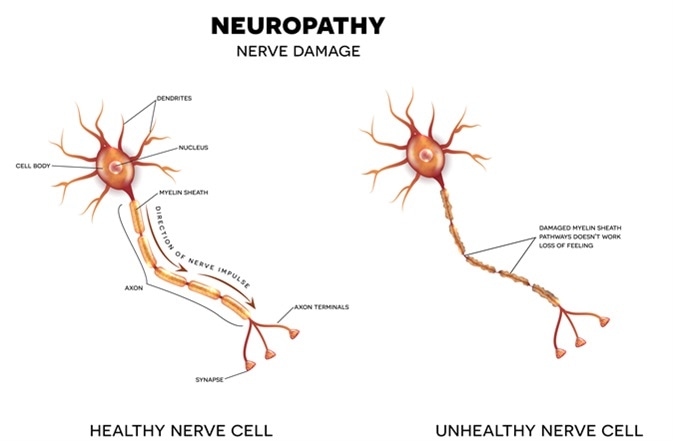Small fiber neuropathy (SFN) is a neurological disorder which primarily affects the small, sensory nerve fibers of the peripheral nervous system. SFN damages either small myelinated (Aδ) fibers or unmyelinated C fibers.
These fibers are involved in sensory functions such as thermal sensitivity and nociception (sensory nervous system’s reaction to harmful stimuli). Also, these fibers are associated with various types of autonomic and enteric functions.
SFN results primarily from the loss or destruction of small nerve fibers or else because of an alteration in the morphology of small nerve fibers. However, the exact cause of destruction of small nerve fibers is still unknown.

Symptoms of SFN
Majority of small fiber neuropathies manifest in a length-dependent manner, which results in a symmetrical loss of function. Loss of functioning initially manifests in the lower extremities in a stocking distribution. If it progresses to the upper extremities it manifests in a glove pattern of nerve symptoms. Rarely, a non-length-dependent neuropathy manifests over the trunk, face, proximal limbs, or other focal areas.
Symptoms of SFN may differ extensively in severity. Broadly, they are classified into sensory and autonomic symptoms.
Sensory Symptoms
Destruction or loss of small nerve fibers results in pain, tingling, numbness or a burning sensation in the lower extremities, with a distal to proximal gradient. Affected individuals typically complain of the gradual onset of indistinct sensation, especially in the feet. They often complain of an unusual feeling such as a sock crumpling up over the feet. Some complain of a feeling as if small stones were stuck in their shoes or as if they were walking on sand. Others report feeling as if their feet have become hard like wood.
Besides the above, patients have also reported symptoms such as a burning pain in the feet, a classic symptom which worsens in a stocking-glove distribution. The symptoms are aggravated over time, and patients complain of stabbing pain associated with cramps, electric shock or needle sensation in the feet and calves.
Symptoms of SFN usually flare up at night and individuals often experience disturbed sleeping patterns. As the symptoms progress individuals cannot tolerate even the touch of light clothing on their feet. Others complain of a feeling of swelling or tightness of the feet, even though the feet are visibly normal.
A medical examination reveals:
- Allodynia (excessive sensitivity such that non-painful stimuli are perceived as painful)
- Hyperalgesia (painful stimuli more acute than typically expected)
- Minimal thermal sensation or pricking sensation
- Mild vibratory sensation in the feet
However, the general motor vigor, proprioception and reflexes of tendons are not affected, primarily because these functions are regulated by large nerve fibers.
Autonomic Symptoms
Autonomic symptoms develop when autonomic fibers are damaged. Affected individuals usually complain of:
- Dry eyes and mouth
- Orthostatic (Postural) dizziness
- Constipation
- Sexual problems
- Excessive sweating
- Skin discoloration
- Wasting of skin
- Edematous (accumulation of water) skin
Causes of SFN
The main cause of SFN has been linked with various medical problems. Below is the list of various medical conditions associated with SFN:
- Glucose dysmetabolism in conditions like diabetes or prediabetes
- Connective tissue disease
- Dysthyroidism
- Vitamin B12 deficiency
- Paraproteinemia or monoclonal gammopathy (a condition when excessive amounts of paraprotein or single monoclonal gammaglobulin accumulates in the blood)
- Human immunodeficiency virus (HIV) infection
- Hepatitis C virus infection
- Celiac disease
- Restless legs syndrome
- Neurotoxic drug exposure
- Hereditary diseases
- Paraneoplastic syndrome ( a collective symptom of rare disorders that are activated by an altered immune system in response to cancer)
Most of the above mentioned diseases result in the destruction of small nerve fibers in a length- dependent fashion; however, some medical conditions like Sjogren disease, celiac disease, and paraneoplastic syndrome result in SFN in a non-length-dependent manner.
Among all these medical conditions, the leading cause is impaired glucose metabolism, accounting for painful sensory neuropathy in over one-third of affected patients. Studies have also indicated a close association of SFN with metabolic syndrome. The metabolic syndrome is a collection of various conditions like of hyperlipidemia, hypertension, obesity and impaired glucose metabolism coupled with insulin resistance.
It has been observed that the risk of developing SFN is doubled in individuals affected with diabetes and metabolic syndrome compared to individuals with diabetes alone. Although, hereditary medical conditions linked with SFN have been found to be rare, some hereditary conditions closely linked with SFN include Fabry disease, Tangier disease, hereditary sensory autonomic neuropathy, and hereditary amyloidosis.
Sources
- www.mdedge.com/…/1
- www.hopkinsmedicine.org/…/small_fiber_sensory_neuropathy.html
- https://www.ncbi.nlm.nih.gov/pmc/articles/PMC3086960/
- www.pijn.com/…/
Further Reading
- All Small Fiber Neuropathy Content
- Small Fiber Neuropathy Diagnosis and Treatment
- What is Small Fiber Neuropathy?
Last Updated: Feb 27, 2019

Written by
Akshima Sahi
Akshima is a registered dentist and seasoned medical writer from Dharamshala, India. Akshima is actively involved in educating people about the importance of good dental health. She examines patients and lends free counseling sessions. Taking her passion for medical writing ahead, her aim is to educate the masses about the value of good oral health.
Source: Read Full Article
